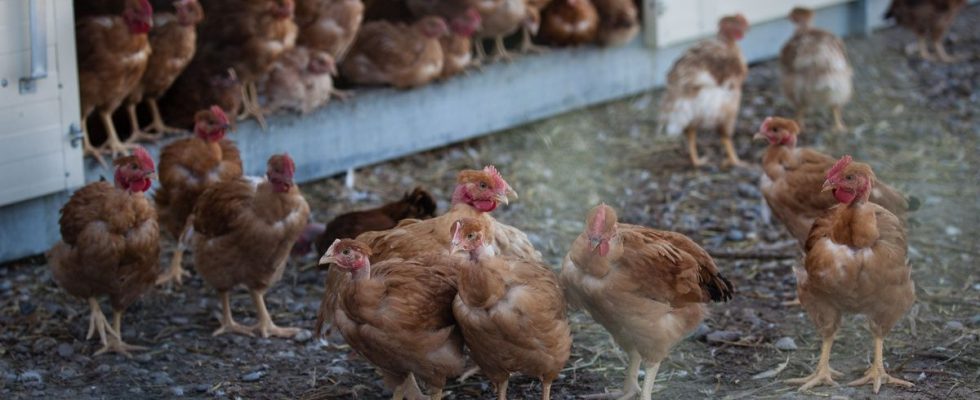The cases are sporadic, but there seem to be more and more human contaminations by avian influenza. In China, a woman has died after contracting the H3N8 strain of the virus, which has been circulating since 2002 and which has so far had no known human casualties, the World Health Organization said a few days ago ( WHO). At the same time, in Chile, scientists discovered in a man infected with the H5N1 strain of bird flu that he was carrying a virus with two genetic mutations, likely to make it more transmissible to humans.
What do these contaminations mean? Could a mutant strain of bird flu cause a pandemic? 20 minutes takes stock of what we know about the virus.
What do we know about the H3N8 strain of the virus?
The H3N8 virus, which first appeared on the North American continent, was until now considered capable of being transmitted to horses, dogs and sea lions. It had not been detected in humans until the first two non-fatal cases in China in April and May 2022.
The deceased is a 56-year-old resident of Guangdong Province in southeast China. She fell ill on February 22, was hospitalized with severe pneumonia on March 3 and died on March 16, according to the WHO. “The patient had multiple predispositions. She had a history of exposure to live poultry prior to illness onset, and a history of wild birds around her home,” the organization said.
Visiting a live bird market could have caused this contamination, but “the exact source of this infection remains to be determined, as well as the link between this virus and the other type A (H3N8) avian influenzas circulating in the environment. animal,” the WHO added, calling for research into the matter. The organization stressed that the available data showed that this virus is not transmitted between humans and that, therefore, “the risk of its spread at the national, regional and global level is considered to be low”. The WHO, however, reiterated the need for constant monitoring due to the permanent mutations of viruses.
What are the particularities of the H5N1 strain, identified in a man in Chile, and where does it occur?
Another country and another strain: in Chile, a 53-year-old man was infected in March with the H5N1 strain of the virus. A sample taken from the patient revealed that the virus he had contracted contained two genetic mutations indicating an adaptation to mammals, officials from the Centers for Disease Control and Prevention said a few days ago. Studies have shown that these mutations, seen in the PB2 gene, help the virus replicate better in mammalian cells.
And in recent years, H5N1 has spread across the globe. Since October 2021, “Europe has been suffering from the epizootic [épidémie animale] most devastating highly pathogenic avian influenza it has ever known, recalls Public Health France. Many outbreaks, mostly due to the H5N1 virus, have been identified in domestic poultry and wild birds, leading to the slaughter of several million birds. The geographical extent of this epizootic is also unprecedented, with almost all of the continents affected, in particular Europe, Asia, the Americas and to a lesser extent Africa”.
In France, “315 outbreaks in breeding have been confirmed since August 1st,” reports the Ministry of Agriculture. And in the wild avian fauna, “the number of cases has also increased sharply in France in 2022-2023 with hundreds of infected birds found dead on the territory, and an endemization of the infection of the avifauna which extends to non-migratory birds”, adds Public Health France.
Is there a risk of human-to-human transmission, or even an avian flu pandemic?
“Although most avian viruses do not infect humans, certain subtypes sometimes manage to cross the species barrier: this is the case of the H5N1 virus, pathogenic for humans and present in Asia, recalls the Pastor Institute. At present, the transmission of the virus is only from animals to humans, but the health authorities fear an evolution of the virus towards a form transmissible from human to human, opening the door to a pandemic”.
The risk in the general population remains low, health officials in Chile said, and no additional human cases have been linked to the infected man, who remains hospitalized. The news is all the more reassuring as the sample taken from the patient indicates that the virus does not carry other genetic mutations that would help it spread better among humans. “There are three main categories of changes that we think H5N1 must undergo to go from an avian virus to a human virus, assured the New York Times Richard J. Webby, bird flu expert at St. Jude Children’s Research Hospital, USA. The sequences of the virus identified in the patient in Chile carry only one of these categories of changes. The easiest to implement for the virus. For Anice C. Lowen, influenza virologist at Emory University, still in the United States, these observed mutations are “like a step on the way to adaptation to humans and an increased risk for the man. So it is certainly disturbing to see them”.
A “threat” deemed “real” by the Pasteur Institute: “The spread of infection in birds increases the likelihood of the appearance of a new influenza virus in the human population. In addition, the subtype has a great capacity to mutate over time, but also to exchange its genes with influenza viruses belonging to other infecting subtypes of other species. The risk of the appearance of a new virus capable of being transmitted from person to person must be taken into consideration. However, underlines the Institut Pasteur, “the appearance of an influenza virus belonging to a viral subtype completely unknown to the human population, such as H5N1, renders the immune memory of the population ineffective. This is in favor of a pandemic”. But for the time being, the WHO considers that “the risk of transmission to humans of the avian influenza viruses currently circulating is low, and no human-to-human transmission has been documented”.

